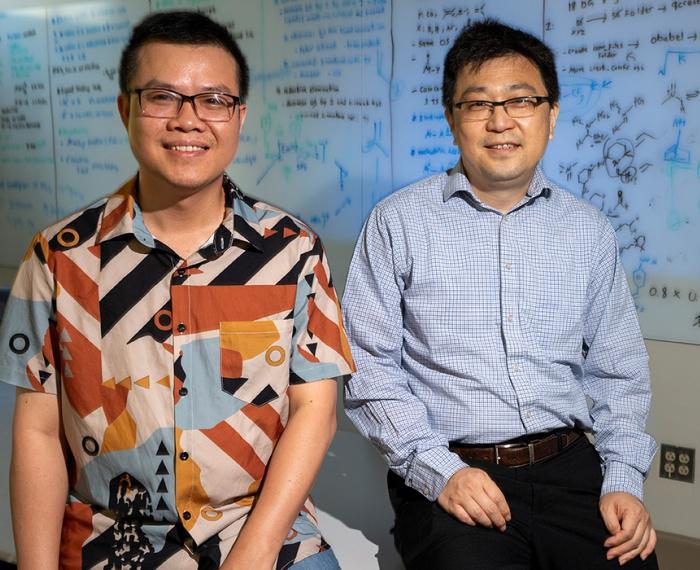Every protein in your body is made up of the same 20 building blocks called amino acids. But just because nature is stuck with a limited toolkit doesn’t mean humans can’t expand it.

Credit: University of Pittsburgh/Tom Altany
Every protein in your body is made up of the same 20 building blocks called amino acids. But just because nature is stuck with a limited toolkit doesn’t mean humans can’t expand it.
A study published in Science on July 27 by a team including Pitt chemists describes a powerful new way to create “unnatural” amino acids, which could find use in protein-based therapies and open up novel branches of organic chemistry.
“This is a completely new transformation: new to nature and new to chemistry,” said Peng Liu, a professor of chemistry in the Kenneth P. Dietrich School of Arts and Sciences and a corresponding author on the paper. “Telling an enzyme to create an unnatural configuration of an amino acid is unusual, and you have to do it with careful bioengineering.”
Change just one piece of a larger protein, and you can alter how it’s shaped and what it does — so unnatural amino acids hold promise for opening up new kinds of therapies like antibiotics or immunosuppressants that make use of proteins or their smaller cousins.
Creating such molecules in the lab, however, is an onerous, multistep process: The pieces of the amino acid that link to one another to form a protein chain have to be protected as researchers chemically transform the rest of the molecule. The reaction described in the new paper, however, is simpler and more efficient, and it offers chemists an unprecedented level of control over how groups of atoms are oriented in the resulting molecule.
It also employs a chemical tool, a PLP enzyme, in an unusual way. Enzymes are proteins that catalyze reactions — typically, even when their functions are altered by bioengineering, all they can do is speed up known chemical processes that chemists could achieve in other, albeit slower ways. But paired with a light-sensitive molecular catalyst, the enzyme in this new reaction can achieve far more than that.
“You can argue that bioengineered enzymes provide better efficiency than small molecule catalysts, but they catalyze the same reaction,” said Liu, pictured right. “But this is an entirely new reaction. It simply didn’t exist before.”
Liu’s group uses computer simulations to figure out the intricate dance that happens in a chemical reaction on the level of atoms and electrons, adding the “why” to the “what” discovered by groups that conduct experiments. For this paper, Liu and Pitt postdoctoral researcher Binh Khanh Mai, pictured left, worked with a team of researchers at UC Santa Barbara led by Yang Yang — a collaboration that’s been going strong since 2014, when Yang spent a summer in Liu’s lab as a visiting graduate student.
Liu and Mai dove into the data provided by Yang’s group to understand how and why the reaction took place, puzzling out the intermediate steps that are invisible to chemists. In one step the duo took a particularly close look at, an electron has to travel an unusually long distance on its path between two molecules. “We had to do some careful modeling about the likelihood of this because this is the step that’s new to nature, and it supports the entire reaction mechanism,” Liu said.
Underpinning those models is tremendous computing power. Liu cites Pitt’s Center for Research Computing as an essential ingredient in the lab’s success, as the complex simulations the group performs to understand the intricacies of chemical reactions requires time with cutting-edge, powerful supercomputers.
Even so, there are questions still unanswered, and this paper is just the first step in a series of collaborations between the two teams. If they can better understand why the unusual reaction happens, Liu’s group may open up the ability to harness it in different contexts to create a wide variety of new chemical tools, medicines and more.
“You can think about how many different types of unnatural amino acids you could make — there are an almost unlimited number,” Liu said. “So can we use this insight to develop other new reactions, too?”
— Patrick Monahan, photography by Tom Altany
Journal
Science
DOI
10.1126/science.adg2420
Method of Research
Experimental study
Subject of Research
Not applicable
Article Title
Stereoselective amino acid synthesis by synergistic photoredox-pyridoxal radical biocatalysis
Article Publication Date
27-Jul-2023
COI Statement
A provisional patent application (US provisional patent number 63/437,491) has been filed through UCSB based on the results presented herein.




